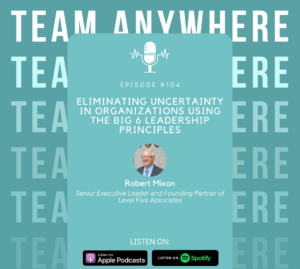 I was pleased to be a guest on “Team Anywhere,” a podcast that discusses team building, remote/hybrid leadership, and strategies for strengthening team relationships. The podcast is produced by the Simon Leadership Alliance, a leadership consultancy that focuses on digital and remote work.
I was pleased to be a guest on “Team Anywhere,” a podcast that discusses team building, remote/hybrid leadership, and strategies for strengthening team relationships. The podcast is produced by the Simon Leadership Alliance, a leadership consultancy that focuses on digital and remote work.
Here are some leadership concepts we discussed:
Coping Vs Adapting
Coping is a methodology of getting by. It’s surviving. Adapting is a more deliberate, thoughtful approach where you are deliberately addressing the needs of your team. As a servant leader, you’re meeting those deeds or exceeding those needs because you’re anticipating what they are. You’re listening for feedback, you’re assessing it. You’re communicating in a meaningful way… and people know that you care.
Decision Trees
You demonstrate trust by actively empowering others. To lead, to make decisions. I like a tool called a decision tree.
I once posted a blog that asked, “is your decision tree a Fir tree, or a Palm tree?” In organizations where it is a Palm tree, that’s because all decisions are made at the top. Meanwhile, the healthiest cultures are Fir trees, where most of the decisions are made by the people who have boots on the ground — the people that are actually doing the work.
The Azimuth
I like to approach ‘Setting the Azimuth‘ as a team exercise… as a team workshop where the leadership team gathers and we collectively address each of the four elements of the azimuth: Mission, Intent, Values, and Culture.
For example, everybody thinks they know what their team mission is, but very few people really do because it’s not very often specified.
The mission is: “Who are we? What do we do? Why do we do it?” Put those answers into one or two sentences, and that is a mission. And when you build a mission as a team or you find a mission as a team, then the team owns it. If you don’t do that together, then it’s just the boss’s good idea.
The same is true of the intent. Develop the intent together. What’s our end state? What does success look like? And what are those key tasks we must perform in order for the end state to come to life?
Values — “What are our beliefs and ideals as a team, an organization, a company?”
Culture — “What kind of behaviors do we expect out of our team members on a daily basis to bring our values to life?”
The azimuth process creates alignment, and the benefits will flow from it.
Power Questions
I like to use question architecture to guide conversations. And I believe that what they do is they help you connect with people in a more meaningful way. I like to use ‘power questions.’
“How’s it going?” is not a power question. Nor is “What’s up?” A power question is one that’s going to elicit some information you can use as a leader.
One of the examples I like is “What’s the biggest challenge you’re facing this week, and why?” That’s going to generate some information. You may not want to hear that answer. You may not like hearing that answer, but it is going to be usable information as a leader.
Just asking people power questions is only part one. The second part is following up. And I believe that’s a shortfall many of us have, is we finally get to the power questions, and then we don’t follow up. So, people say, “Well, they didn’t really want to know the answer to that question” because there was no follow-up to it.
The true conversation occurs in one-on-one meetings, not one-on-fifty. One-on-one meetings are essential to this development.
Translating Value into Behavior
Values are what bring an organization together and guide each team member to act in unison toward a common goal. However, it is paramount to convert this value to a tangible belief that comes to life in a measurable way. Anything that can be measured can be improved upon and gets done.
The translation of these values into real, actionable behaviors ultimately creates a powerful force moving in the same direction.
If you’d like to dive into the full episode, my guest visit on the Team Anywhere podcast is available here:
For more interviews and leadership insights, you can check out other Team Anywhere episodes here.
The Team Anywhere podcast is also available on all major podcast apps.
Enjoy the journey!
Did you find this blog post beneficial? If so, please consider sharing it with your audience using one of the choices below. It’ll just take a second, but could improve someone’s work habits for a long time to come.





